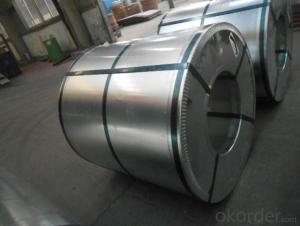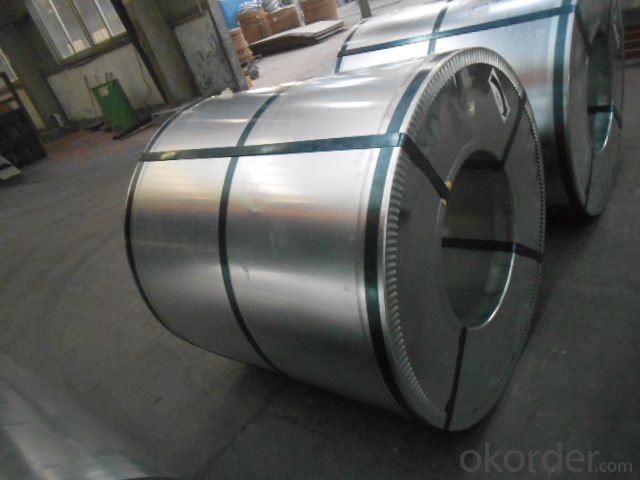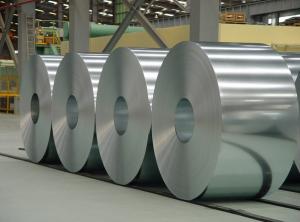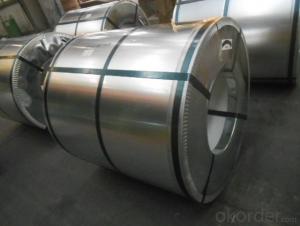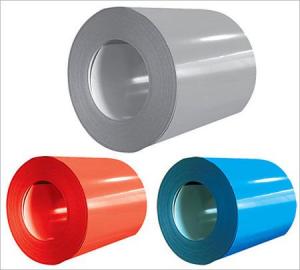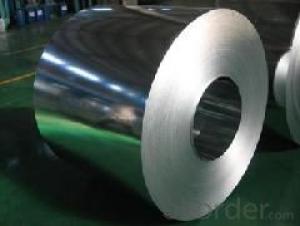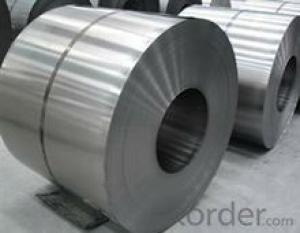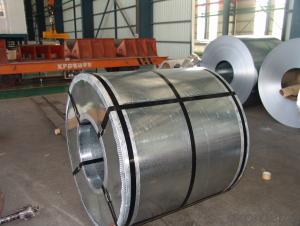Hot Dip Galvanized Steel in Coil in Coil
- Loading Port:
- Tianjin
- Payment Terms:
- TT OR LC
- Min Order Qty:
- 25 m.t.
- Supply Capability:
- 5000 m.t./month
OKorder Service Pledge
OKorder Financial Service
You Might Also Like
Description:
Galvanized Steel Coil gets coated in layers of zinc because rust won't attack this protective metal. The most external layer is all zinc, but successive layers are a mixture of zinc and iron, with an interior of pure steel. These multiple layers are responsible for the amazing property of the metal to withstand corrosion-inducing circumstances. Zinc also protects the steel by acting as a "sacrificial layer." If rust does take hold on the surface of Galvanized Steel Coil, the zinc will get corroded first. This allows the zinc that is spread over the breach or scratch to prevent rust from reaching the steel. For countless outdoor, marine, or industrial applications, Galvanized Steel Coil is an essential fabrication component.
Superiority:
1. Good Resistance to Corrosion
2. Qualified Processing Machinability
3. High Thermal Resistance
4. Excellent Reflectivity
5. Inexpensive and effective enough
6. Can be recycled and reused multiple times
Application:
With excellent cold bending molded manufacturability, good decoration effect, strong anti-corrosion ability, galvanized steel coils and sheets are also pollution-free and easily recycled. Accordingly, they can be used as final products and basic plates of color coated steel coils and widely applied in construction, home appliances, decoration
1. Architecture Roofs and outside walls of civilian and industrial buildings, garage doors, fencings and window blinds
2. Appliances Industry Outer clad sheets for washing machine, refrigerator, television, air conditioner and ventilation system, explosion-proof strip, solar water heater and appliance parts
3. Auto Industry Muffler, heat shields of exhaust pipe and catalytic converter, auto parts & accessories under the frame, signboard in highway
4. Industrial Instruments Electric control cabinet, industrial refrigeration equipment, automatic vending machine
Construction field ,ships building industry ,Petroleum and chemical industries ,war and electricity industries ,food processing and medical industry, boiler heat exchanger, machinery and hardware fields
Electrical Appliance:refrigetator.washer,switch cabinet,etc
Furniture:central heating slice, lampshade, etc
Product Specification:
Material:SGCC,DX51D,Q195
Thickness: 0.3-3.0mm
Width: 600-1500mm
Inner Diameter: 508mm, 610mm
Weight of Steel Coil: 3-15MT
Coating Type: Al-Zn Alloy
Available Dipped Layer: 50-150g/m2
Surface Finish Structure: Normal Spangle & Small Spangle & Zero Spangle
Steel grade & Standard: JIS G3302 SGCC
Spangle: Normal spangle, large spangle, small(min) spangle, zero spangle
FAQ:
1.How about the package for the Hot Dip Galvanized Steel in Coil?
Usually Standard export seaworthy package: waterproof paper+steel trip packed+wooden case seaworthy package
Package:Covered with waterproof-paper, strapped by strips. Standard seaworthy export package:4 eye bands and 4 circumferential bands in steel, galvanized metal fluted rings on inner and outer edges, galvanized metal & waterproof paper wall protection disk, galvanized metal & waterproof paper around circumference and bore protection.
2. Can I know the production period of the goods?
Usually it need 20 days for 25tons in one container. We can produce 300 tons per day but we need to arrange the production in advance.
3. How about the label, could you make the label according to pour requirements?
Usually we use the MILL label, but if you need special form we can make.
- Q: What are the challenges in the production of steel coils?
- There are several challenges in the production of steel coils. Firstly, maintaining consistent quality and meeting the desired specifications can be difficult due to variations in raw materials, production processes, and equipment performance. Secondly, ensuring efficient and cost-effective production requires careful planning and optimization of various factors such as energy consumption, material handling, and logistics. Thirdly, the steel industry faces environmental challenges related to emissions, waste generation, and resource consumption, which necessitate sustainable practices and compliance with regulations. Lastly, competition in the global market demands continuous improvement and innovation to stay ahead in terms of product quality, cost competitiveness, and customer satisfaction.
- Q: How are steel coils coated for added protection?
- To enhance their durability and resistance to corrosion, steel coils undergo a process known as coil coating, wherein a protective layer is applied onto their surfaces. There are several methods employed to coat steel coils, but the most commonly used one is the continuous coil coating process. Under this process, the steel coil is unwound and extensively cleansed to eliminate any contaminants or impurities on its surface. This step ensures proper adhesion of the coating material. Once the steel coil is cleansed, it undergoes a pre-treatment to enhance its surface properties. Typically, this involves the application of a chemical solution or a conversion coating onto the coil's surface. The aim of this step is to create a surface that is receptive to the coating material and improves its adhesion. Following the pre-treatment, the steel coil is coated with a protective layer, which can be in the form of liquid paint, powder coating, or a combination of both. The coating material is applied evenly onto the coil's surface using techniques like roll coating, spray coating, or electrostatic coating. Once the coating is applied, the steel coil is cured or dried using heat or, in some cases, ultraviolet light. This curing process ensures a strong bond between the coating material and the steel surface, resulting in the desired protective properties. The coated steel coil then undergoes inspection to ensure quality control measures like thickness, adhesion, and appearance are met. If the specifications are satisfied, further processing may take place, involving cutting, slitting, or forming the coil into the desired shape or size. In conclusion, the process of coating steel coils for added protection involves thorough cleansing, pre-treatment, application of a protective coating, curing, and quality control. This ensures that the steel coils exhibit excellent resistance to corrosion, abrasion, and other environmental factors, making them suitable for a wide range of applications across various industries.
- Q: How do steel coils contribute to structural integrity in buildings?
- The role of steel coils in ensuring the structural integrity of buildings cannot be overstated. They play a vital role in multiple ways. To begin with, steel coils are extensively utilized in the construction industry to manufacture essential building components like beams, columns, and trusses. These components are responsible for providing support and stability to the overall structure. Due to their exceptional tensile strength and durability, steel coils guarantee that these components can withstand heavy loads and maintain their structural integrity over an extended period. This is particularly crucial in buildings with multiple floors or large open spaces, where the structural elements need to bear substantial weight without deforming or collapsing. Moreover, steel coils are also instrumental in reinforcing concrete structures. Reinforced concrete is a widely adopted construction technique, and steel coils, in the form of reinforcement bars or mesh, are embedded within the concrete to counteract tensile forces. While concrete excels at withstanding compressive forces, it is weak in tension. By incorporating steel coils, the composite material gains the ability to resist both compression and tension, thereby enhancing its structural integrity. This reinforcement technique is particularly vital in high-rise buildings or structures subject to seismic activity, where the risk of structural failure due to bending or cracking is heightened. Another significant contribution of steel coils to structural integrity lies in their corrosion resistance properties. Steel coils are often coated with protective layers, such as zinc through galvanization or paint, to prevent corrosion caused by moisture, chemicals, or environmental factors. Corrosion weakens the structural integrity of steel, leading to degradation and potential failure. By utilizing corrosion-resistant steel coils, the lifespan of the building is prolonged, and the risk of structural damage is significantly diminished. Furthermore, steel coils offer tremendous versatility in design and construction. Their flexibility and malleability allow for the creation of complex and intricate building structures, enabling architects and engineers to push the boundaries of design while maintaining structural integrity. Steel coils can be shaped, bent, and welded into various forms, making them an ideal material for constructing innovative and aesthetically pleasing buildings. In conclusion, steel coils are indispensable in ensuring the structural integrity of buildings. Their strength, stability, durability, corrosion resistance, and design versatility make them an essential material in modern construction, guaranteeing the safety and longevity of buildings for years to come.
- Q: How are steel coils used in the production of metal staircases?
- Steel coils are used in the production of metal staircases as the main raw material. They are uncoiled and cut into sheets, which are then shaped and welded to create the structural components of the staircase, such as the stringers and treads. The strength and durability of steel make it an ideal material for constructing sturdy and long-lasting staircases.
- Q: How are steel coils used in the production of automobile frames?
- Steel coils are an essential component in the production of automobile frames. These coils, made from high-quality steel, are first uncoiled and then fed into a stamping press where they are shaped into various parts of the frame. The steel coils provide the necessary strength and rigidity required to support the weight of the vehicle and ensure its structural integrity. Once the coils are stamped into the desired shape, they are often welded together to form the frame structure. This welding process helps to join the individual components securely, ensuring that the frame can withstand the forces and stresses encountered during the vehicle's operation. The use of steel coils in automobile frame production also allows for flexibility in design, as they can be easily shaped and manipulated to meet specific requirements. Furthermore, steel coils offer excellent durability and resistance to corrosion, making them ideal for automotive applications. The frames produced using these coils are strong, reliable, and able to withstand harsh conditions and road vibrations. This not only enhances the safety of the vehicle but also contributes to its longevity and overall performance. In addition to automobile frames, steel coils are also used in other critical components of the vehicle, such as suspension systems, chassis, and body panels. Their versatility, strength, and cost-effectiveness make them a preferred choice in the automotive industry. Overall, the utilization of steel coils in automobile frame production plays a significant role in ensuring the safety, durability, and performance of modern vehicles.
- Q: a picture of the atomic structure of carbon steel
- This is actually a quite complex question... The atomic arrangement in steels can be controlled over a pretty wide range of different structures. This is really the fundamental reason why steel is such a commonly used material. The different atomic structures produce different physical properties so metallurgists have developed many different processes to control the atomic structure to get the properties they want. One simple answer is that Fe is BCC, body centered cubic at room temperature at equilibrium conditions. When you heat Fe up, it transforms to FCC, face centered cubic. If you continue heating Fe, it goes back to BCC, then it melts. The addition of C makes these structures (and the transformation temperatures) different. Deviating from equilibrium conditions by, for example, cooling very quickly (quenching) creates different atomic structures (one of the most important is known as martensite). Depending on how much C is in the steel, you can also have two different atomic structures (two different phases) present in equilibirum, for example, pearlite which is a mix of alpha Fe (BCC) and iron carbide Fe3C (orthorombic crystal structure). So... you need to think a little more about exactly what you want a picture of. I hope this helps
- Q: what is the densest type of steel ? what is its density ?what is its tensile strength .
- Technically, any metal that is not pure could be considered a steel alloy with the addition of iron. Density will vary depending on the percentage of each alloying element. In commonly available alloys, those with a high percentage of nickel will be the most dense. Nickel has a high molecular weight and readily alloys with most other metals. This class of materials is stainless steels, heat resistant super alloys such as inconel, hastalloy, etc. Tensile strength is not directly related to nickel content. Elements such as boron, manganese, molybdenum, and chromium have the most effect on tensile strength in steel alloys both as rolled and heat treated. Hope that answers your question.
- Q: How is the quality of steel coils determined?
- The quality of steel coils is determined by various factors including the chemical composition, mechanical properties, surface finish, and dimensional characteristics of the coils. Additionally, factors such as the manufacturing process, heat treatment, and adherence to industry standards and specifications also play a significant role in determining the quality of steel coils. Thorough testing and inspection procedures, such as visual inspections, hardness tests, tensile strength tests, and non-destructive testing methods, are employed to ensure the quality and reliability of steel coils.
- Q: What are the common methods of slitting or shearing steel coils?
- The common methods of slitting or shearing steel coils include rotary shear, guillotine shear, and laser cutting.
- Q: How do steel coils contribute to the automotive lightweighting trend?
- Steel coils contribute to the automotive lightweighting trend in several ways. First and foremost, steel coils are used in the production of advanced high-strength steels (AHSS) which offer a higher strength-to-weight ratio compared to traditional steel grades. These AHSS can provide the same structural integrity as conventional steel, but with reduced weight. By incorporating AHSS into the construction of vehicle components such as body panels, chassis, and suspension systems, automakers can reduce the overall weight of the vehicle, thus improving fuel efficiency and reducing emissions. Furthermore, steel coils are used in the manufacturing of tailor-rolled blanks (TRBs). TRBs are formed by welding or bonding different steel grades together in a coil before stamping them into the desired shape. This allows for the optimization of material usage, as stronger steel grades can be strategically placed in areas that require higher strength, while lighter grades can be used in less critical areas. This technique not only reduces weight but also enhances safety by reinforcing necessary areas of the vehicle. Moreover, steel coils enable the production of thinner and more formable steel sheets. The advancements in steelmaking technology have allowed for the development of thinner gauges without compromising strength and durability. Thinner steel sheets are easier to shape and form, enabling the creation of complex and lightweight automotive parts. This not only reduces weight but also improves design flexibility and aerodynamics, leading to enhanced performance and fuel efficiency. In addition, steel coils contribute to cost-effectiveness in lightweighting efforts. Steel is a relatively affordable material compared to alternatives like aluminum or carbon fiber. By utilizing steel coils, automakers can achieve lightweighting goals while keeping manufacturing costs under control. This affordability aspect is particularly important in the automotive industry, where cost considerations play a significant role in the design and production of vehicles. In summary, steel coils play a crucial role in the automotive lightweighting trend by enabling the production of advanced high-strength steels, tailor-rolled blanks, thinner and more formable steel sheets, and cost-effective lightweight solutions. These advancements contribute to improved fuel efficiency, reduced emissions, enhanced safety, and increased design flexibility, all of which are key factors in the ever-evolving automotive industry.
Send your message to us
Hot Dip Galvanized Steel in Coil in Coil
- Loading Port:
- Tianjin
- Payment Terms:
- TT OR LC
- Min Order Qty:
- 25 m.t.
- Supply Capability:
- 5000 m.t./month
OKorder Service Pledge
OKorder Financial Service
Similar products
Hot products
Hot Searches
Related keywords
